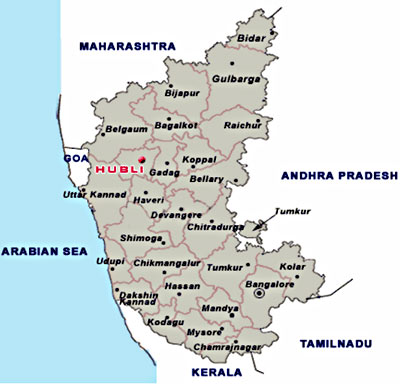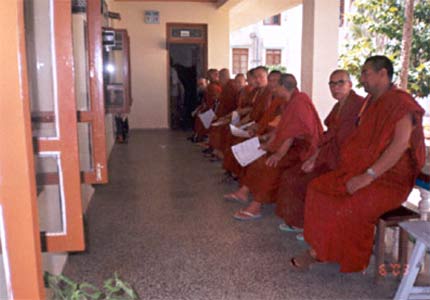return to itm online
Update on Drepung Gomang Community Dispensary
by Subhuti Dharmananda, Ph.D., Director, Institute for Traditional Medicine, Portland, Oregon

| Drepung Gomang Monastery is a Tibetan exile community in southern India, near the city of Hubli. It is one of several such refugee camps in this area that was set aside by the Indian government. There are more than 1,700 monks at the Drepung Gomang site studying Buddhist philosophy in a rigorous program. Most of the monks are from Tibet. They left their homeland, risking their lives in crossing the dangerous border, for better opportunities to study and practice their religion, and to be able to have contact with and get blessing from His Holiness the Dalai Lama. In Tibet, religion is suppressed, the monasteries have been destroyed or are in disrepair, and there is no access to the Dalai Lama or the rest of the Tibetan Buddhist leadership. With generous funds and assistance from its friends around the world, the monastery has been able to survive during the past 35 years.
In 1999, with a special fund from ITM, Drepung completed construction of a medical clinic (dispensary) on their land to provide medical assistance to the monks, as well as for Tibetan lay people who are living in the community and Indians in nearby villages. The clinic is a 3,000-square-foot structure that is open daily to the public from 7 A.M. to 6 P.M. (except Mondays). There are 11 rooms, including a large room with beds for patients, a doctor's office, medicine counter and store room, dressing room, small lab, small staff office, a room for a visiting doctor with bathroom attached, and a toilet for patients' use.
|
The chief physician, Dr. Sherab Gyatso, from Tibet, has formal training in Tibetan medicine; he resides at the Dispensary and is always there if he is needed. Dr. Sherab performs Tibetan acupuncture and prescribes Tibetan herbal medicines as well as Western pharmaceutical medicines. The Western medicines are on hand at the dispensary, but to obtain the Tibetan medicines, the patients have to go to the local Mentsekhang (the settlement's Tibetan Hospital) to purchase them. It is only 10 minute walk to reach there.
There are six staff members working with him. All the staff members are monk volunteers of the monastery who have dedicated their lives to serving the poor and needy. Most of the monks don't have any formal medical education. However, one of the staff members, Venerable Tashi Dorjee, has taken part in many health workshops and is able to provide professional help. Also, a monk who works in the laboratory is trained to check sputum for the diagnosis of tuberculosis, to test blood type, and to perform other basic laboratory analyses. He received formal training at the Settlement Hospital.
The clinic offers basic diagnostic services, acupuncture, and dispensing of medicines, mainly Western medicines, though also a few Ayurvedic formulations (from Universal Medicaments of Nagpur) are provided. Certain ailments are especially common: stomach ulcer, diarrhea, fever, severe chills, pain, jaundice, high blood pressure, and diabetes. The five most-commonly prescribed medicines at the dispensary are: acetaminophen (for fever and pain); omeprazole (for gastric ulcer); ciprofloxin and Amoxillin (for infection); and Cetirizine (for allergies). Additionally, various common cold tablets and cough syrups are frequently utilized.
No surgical procedures are carried out at the dispensary; all surgical cases are referred to hospitals. Similarly, patients with serious medical problems may avail themselves of services from either the Tibetan Hospital in the Tibetan Settlement or from the Indian hospital located in nearby city of Hubli or the one in the larger city of Bangalore. Using funds set aside specifically for this purpose, 70% of the hospital bills incurred by the Drepung Gomang monks are refunded upon submission of a verifiable copy of the medical invoice.
Medical consultations at the dispensary are free and the charges for medicines are minimal. There are about 125 visits to the dispensary each day (750 visits per week; sometimes more when seasonal workers are present or when visiting doctors are available). The continuance of this medical care is dependent entirely upon the generosity of donors.
Other than above services, Drepung Gomang Dispensary has been inviting Indian doctors (e.g., child specialists, dermatologists, optometrists, internal medicine physicians, etc.) to the dispensary to provide special check-ups twice a month. The response to this offer has been encouraging. Since the consultation is free, many people from all walks of life come to the dispensary for these check ups.
On the occasion of big religious gatherings such as Kalachakra (special teachings of His Holiness), the dispensary staff have been able to set up a small clinic, giving free consultation and medical assistance. This was done, for example, during Kalachakra 2002 and also during His Holiness' teachings at Mundgod, a nearby town.
The annual budget for the dispensary is about $35,000 (U.S.), a cost of about $1/patient visit (including part of the cost of the medicines and contributions to care at other facilities), of which only about 2/3 of the necessary funds are currently available, the rest is a deficit that needs to be made up from additional donations.
Funds from foreign donors are also used for many other projects at Drepung Gomang, such as a tree plantation project (to provide food, such as mango), running a community kitchen, maintenance of a hostel for newly arrived and visiting monks, purchase of a new tractor, and general welfare of monks. With the continuing increase in the population of monks, the limited funds are adjusted to try and meet the basic needs of every aspect of the monastery. This monastery is the only one in the area that has constructed community latrines (toilets) and bathing facilities for monks and for lay people who visit the monastery. Monks throng to the bath place where water for the bath is supplied from a tap from 2:30-4:30 P.M. Such basic services as the dispensary and bathing facilities are critical to the welfare of the residents.

Dispensary entrance
| 
Monks waiting for services
|
Note: special thanks to Migmar Tsering, Secretary at Drepung Gomang for the report on which this was based.
For more information and photos, see: www.gomang.org.
January 2004


